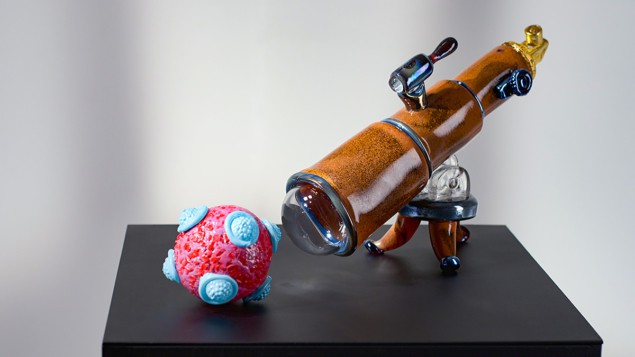Sarah Tesh highlights the crossover between art and science in season 3 of Netflix’s Blown Away

One of my guilty pleasures is watching TV competitions where people make stuff. Whether it’s clothes on Sewing Bee, cakes on Bake Off or pottery on Throw Down, I can’t get enough of the amazing skills and creativity of the contestants. Though sometimes it’s their failures that also make compelling viewing.
At the moment I’m absorbed in a Netflix series called Blown Away. It features 10 glass artists competing to win $60,000 and a residency at Corning Museum of Glass in the US. The challenge for the contestants in each episode is to create a glass sculpture based on a theme chosen by the adjudicators. And of course, at the end of every show, the judges send one artist home until a winner is crowned.
The programme demonstrates the immense strength, skill and determination needed to manipulate molten glass into any recognizable form
I’ve always wanted to have a go at glass-blowing but the programme demonstrates the immense strength, skill and determination needed to manipulate molten glass into any recognizable form, let alone a piece of art. As it takes place in “North America’s largest hot shop” – with furnaces working at around 1000 °C – the contestants are sweating buckets and phrases like “I have never sweat or smelled this bad in my life” are commonplace.
What’s more, the contestants have to be physically strong to handle the glowing orange blobs at the ends of long pipes in this intense environment. Artist Grace Whiteside (one of my favourite entrants) revealed they even hired a trainer to prepare for the competition. But by using weird and wonderful techniques, the artists somehow turn this raw material into delicate structures featuring a myriad of colours within just a few hours. That’s not to say it’s always successful – nearly every episode there’s at least one heart-stopping shattering of glass as a partly made piece crashes to the ground, and the contestant has to start all over again.
Over the course of the three seasons to date, the themes have ranged from standard glass objects – including light fixtures, perfume bottles and drinking vessels – to items that you wouldn’t normally associate with glass such as robots, body parts and food. There have even been more conceptual topics like duality, fears and memories. But it was the third episode in the latest series (season 3) that particularly caught my attention because the theme was the International Year of Glass. Having helped put together a special issue of Physics World devoted to the year, I felt heavily invested.
The remaining eight competitors were asked to make a sculpture inspired by a glass invention that changed the world. But where do you even begin with such a brief? As resident judge and glass artist Katherine Gray said during the episode’s introduction: “There is 5000 years of innovation all around us.”

My mind immediately turned to optical equipment, such as lenses, mirrors and prisms. Surely the manipulation of light would lend itself well to a piece of art made of glass? As I’m not a professional artist, I was therefore pleased when glass-blower Minhi England went down a related route. She fashioned a piece inspired by the glasses that can help people who have a certain type of colour blindness distinguish between wavelengths more effectively. Called Full Colour Spectrum, the sculpture consists of a large clear lens in front of spheres that are positioned and coloured in such a way that it appears the lens provides the colour. While not scientifically accurate regarding the way these glasses work, it is certainly eye-catching.
Of the other seven remaining contestants, two went for fibre-optic cables and another two chose smartphone screens, with each sculpture featuring a nod to either the history of glass or how it connects people. Meanwhile Whiteside mimicked Corning’s famous Pyrex cookware shapes in a slightly distorted way, and Trenton Quiocho made a set of the very recognizable vessels found in every chemistry lab.

For me, the best piece was by John Sharvin (my other favourite contestant). At university he switched from studying engineering to fine arts in glass, which is perhaps why he went down a different path to the other artists. Titled Perspective, his sculpture features a detailed depiction of an old-fashioned telescope directed at a vividly coloured and textured virus.
Sharvin says he was inspired by the controversy Galileo Galilei faced with his findings about the solar system, and how that “debate between scientific evidence and non-science thought has continued throughout history and has increased in recent years”. It was an interesting spin on the brief and I liked the fact he chose a less obvious glass invention.

Blown away by the wonders of glass at Corning’s spectacular museum
The International Year of Glass was not the only reference to science in this latest series. Episode 8’s theme was space, and the sculptures included a floating iridescent Earth, a moon crashing into a planet, and an alien plant giving birth (yes, it was as weird as it sounds). The most interesting part of this episode was the guest judge – space scientist Marianne Mader. She talked about some of the applications of glass in space exploration, and her excitement over the sculptures was that of a scientist who really enjoys seeing their field represented in such a creative way.
As Quiocho puts it when talking about his laboratory glassware, “Science and glass go hand-in-hand, and so I guess the message behind this piece is ‘science is cool’.”



